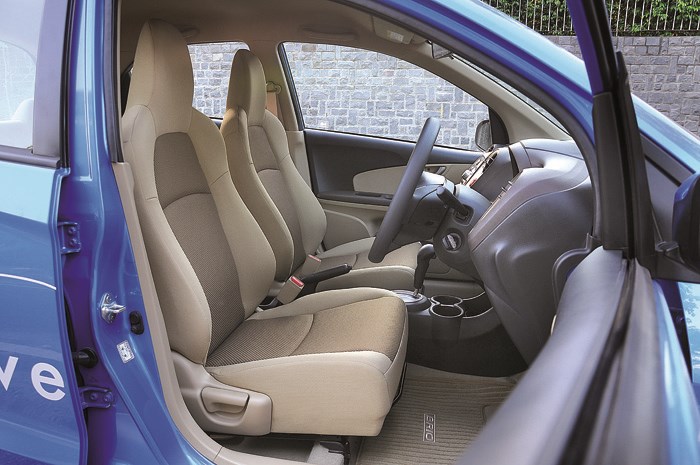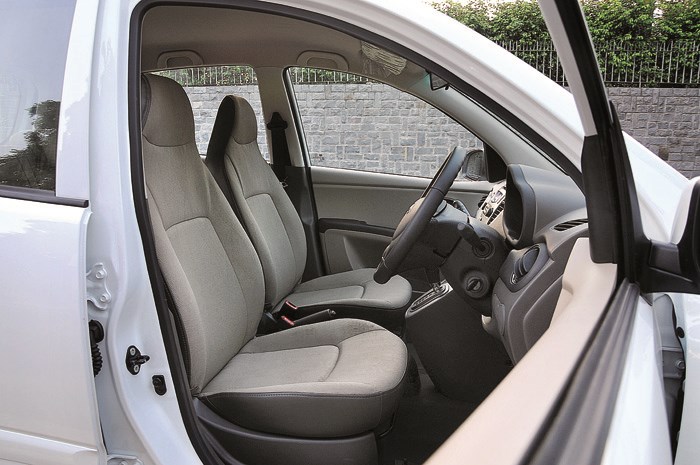Honda Brio Auto vs Hyundai i10 Auto
Both these automatic hatchbacks are very easy to live with. But which one is better?
Published On Nov 02, 2012 10:26:00 PM
80,497 Views
Follow us onA few years ago, people would scoff at the idea of buying a budget hatchback with an automatic transmission. After all, automatic transmission-equipped cars cost a considerable premium over their manual counterparts and, by virtue of being less fuel efficient, are also costlier to run. This double-cost whammy is the key reason why automatics account for less than one percent of sales at the budget end of the market.
Fast forward to the present and the scenario has changed. The ever-worsening traffic has made automatics more attractive than ever before and their improved hardware means these cars won’t inflate your fuel bills by all that much. So what are your options?
Hyundai’s i10 has been the favourite choice in this sub-segment and it’s easy to see why. In automatic avatar, it’s well-equipped, easy to drive and reasonably fuel efficient too. Hyundai hasn’t rested on its laurels either – the i10’s regular revisions with facelifts and engine updates have helped keep it fresh over the five years it’s been on sale. The question is, is that enough? This month Honda will start selling its competent little city car, the Brio, with an automatic transmission. To give you a brief, both the Brio and the i10 have 1.2-litre engines and, going by their manual variants, the Brio Auto will be priced close to the automatic i10. So which one offers the better clutchless experience?
Let’s start with the Brio Auto, which employs the same 1.2-litre i-VTEC, single-cam motor as the manual car. We know this motor to be smooth and free-revving, and it’s no different with the five-speed automatic transmisson either. The torque-converter gearbox is similar to the ones found in the City, Civic and Accord and, as on the other Hondas, is quite adept at its job. Changes in throttle position bring about a reasonably quick change in ratios, and if you choose to press on, the gearbox will let the engine rev to its redline. If there’s a fly in the ointment, it’s that the power delivery is a bit jerky at low speeds and that the engine lacks some bottom-end punch.
On the other hand, the i10 is at its best in typical stop-go city traffic. It may be 9bhp down on the Brio, but the i10’s Kappa2 motor is much more responsive at low revs and, at least at typical city speeds, feels like a larger-capacity motor. The car jumps off the line and the Kappa2 motor revs – albeit not as freely as the Honda – to a 6700rpm redline. The problem is, past 4500rpm, the engine feels strained and doesn’t pull as cleanly to the top as the Brio’s unit. As for the i10’s gearbox, it is quite obedient and responsive to changes in throttle input, but still doesn’t feel as flexible as the Brio’s. That’s because it’s a four-speed unit and, correspondingly, the gearing is on the taller side, which limits its ability to quite an extent. But just like the Brio’s unit, it allows some manual control with slots for first and second gears. Slotted in first or second, both cars will hold gear right up to the redline and have the engine bouncing off the rev limiter.
On all other fronts, these cars are identical to their manual counterparts, so the Brio maintains its position as the more fun car to pilot. It’s got the better steering, the chassis lets you push the car when you’re in the mood for it and, save for some vertical movement on sharp bumps, the ride quality is also good, by and large. The i10 also delivers a pliant ride at low speeds, but drive any faster and the car’s nose will bob and curb your enthusiasm. But that’s excusable, because this car isn’t built for serious speeds or corners. It’s a city car, and around your neighbourhood roundabout, you
are sure to appreciate its light steering. The Brio has a slight advantage while reversing though – that huge glass hatch makes it easy to see out of the back. That brings us to the rest of the cabin.
Honda are masters when it comes to interior packaging and the Brio is a fine example of this. Despite its compact dimensions, the Brio can accommodate passengers in more comfort than many larger hatchbacks. The i10 is reasonably spacious in its own right too, but its rear seats are a bit too upright and the cushioning is a tad too hard.
From the driver’s seat, the Brio wins again. You get a fantastic view and the driving position is spot on, but shorter drivers will miss seat height adjustment, which isn’t available on any version of the Brio. There’s more cost-cutting elsewhere in the cabin too. The exposed metal surface inside the front door pockets and the lack of a rear windshield wiper or defogger tell you where else Honda has saved on costs. For its part, the Brio’s dashboard is well built, but again, the floating centre console gives it a Spartan feel.
The i10, in comparison, has a fuller dashboard that neatly integrates the air-con vents and the music player, and merges nicely into the door-pads. You also get a good view from the relatively high-set driver’s seat, but thigh support isn’t that good and, like in the back, the cushioning is on the harder side too.
As you can tell, it’s a pretty even battle between the new rivals. The i10 is a well-engineered product that’s loaded with features and offers great value for the Rs 6.16 lakh Hyundai is asking. Its four-speed automatic gearbox also does a fairly good job and gives the i10 more than ample performance. But given a choice, we’d still pick the Brio automatic. That’s because the automatic transmission hasn’t seriously diluted the driving experience, which is core to the Brio’s appeal. Then there are the other Brio strengths of a spacious cabin, good ride and excellent engine refinement that all add up to make the Honda a more special car. Sure, you don’t get as many features as on the i10, but in the end, it’s the Brio’s big-car feel for small-car money that clinches it for Honda.
Why no CVT for Brio?
The Brio sold in Thailand comes with a CVT or continuously variable transmission. So it was only logical to expect Honda to equip the car with the same transmission for India. So why does the Indian car use a five-speed torque-converter ’box?
In a word: costs. Honda would have had to import the CVT gearbox from Japan which, given the strong Japanese Yen, would have worked out really expensive. Instead, Honda decided to source the car’s current gearbox from the cheaper production base in Indonesia. But while buyers will save on their initial investment, they lose out on the better efficiency of a CVT vis-a-vis a torque-converter unit. Honda has said it will bring in the CVT ’box if production starts in Thailand.

Copyright (c) Autocar India. All rights reserved.






Comments
Member Login
Personal Details
No comments yet. Be the first to comment.